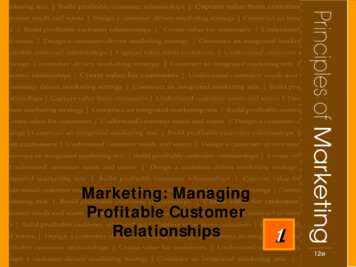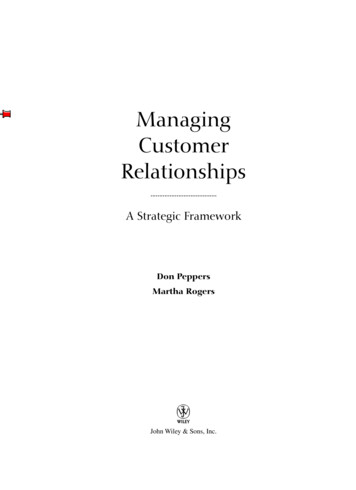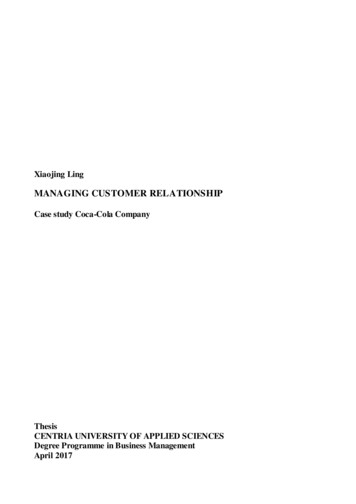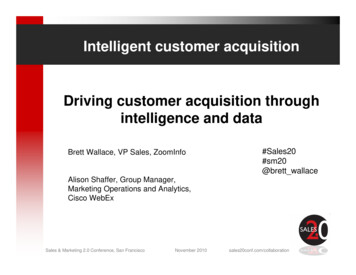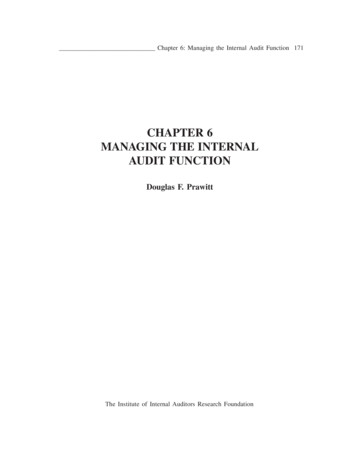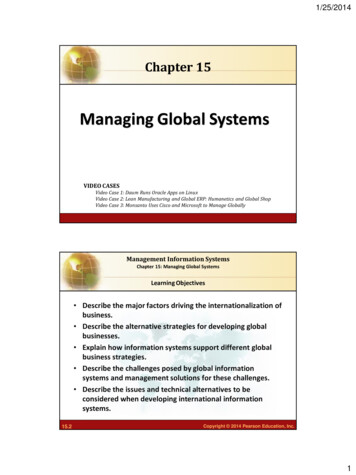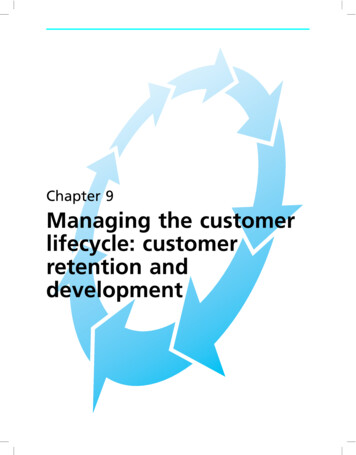
Transcription
Chapter 9Managing the customerlifecycle: customerretention anddevelopment
Chapter objectivesBy the end of the chapter, you will understand:12345what is meant by the term ‘customer retention’the economics of customer retentionhow to select customers to target for retentionthe distinction between positive and negative customer retentionseveral strategies for customer retention, including meeting and exceeding customerexpectations, finding new ways to add value, creating social and structural bonds, andbuilding emotional commitment6 the role of customer development7 why and how customers are ‘sacked’.IntroductionThis is the second of the three chapters that look at the critical issues ofprocess and structure for customer relationship management (CRM)implementation. The core CRM processes are customer acquisition,customer retention and customer development. Together, they make upthe customer lifecycle. The processes of customer retention and development are the focus of this chapter. Customer acquisition is covered inChapter 8, and structure is covered in Chapter 10.In this chapter you will learn about the important issues of customerretention and development.Managing the customer lifecycle is the last primary stage of the CRMvalue chain (Fig. 9.1).We propose that the major strategic role of CRM is to manage acompany’s relationships with customers though three stages of thecustomer lifecycle: customer acquisition, customer retention and customer development.Just as a customer acquisition strategy aims to increase the number ofcustomers in the customer base, a customer retention strategy aims tokeep a high proportion of current customers by reducing customerdefections, and a customer development strategy aims to increase thevalue of those retained customers to the company. Just as acquisition isfocused, so are retention and development. Not all customers are worthretaining and not all customers have potential for development.We will deal with the issue of retention first, before turning todevelopment.
298 Customer Relationship ManagementFigure 9.1CRM value chainSeveral important questions have to be answered when a companyputs together a customer retention plan. Which customers will be targeted for retention?What customer retention objectives should be set?What customer retention strategies will be used?How will the performance of the retention plan be measured?These issues need to be carefully considered and programmed into aproperly resourced customer retention plan. Many companies, perhaps asmany as nine out of 10, have no customer retention plan in place. Asnoted in Chapter 8, most marketing plans fail to distinguish betweencustomer acquisition and customer retention. It is recommended thatcompanies think about these as separate, but related issues, and developappropriate strategies.What is customer retention?Customer retention is the strategic objective of striving to maintain longterm relationships with customers. Customer retention is the mirrorimage of customer defection. A high retention rate is equivalent to a lowdefection rate.1Conventionally, customer retention is defined as:2the number of customers doing business with a firm at the end of afinancial year expressed as percentage of those who were activecustomers at the beginning of the year.However, the appropriate interval over which retention rate should bemeasured is not always 1 year. Rather, it depends on the repurchase cycle
Managing the customer lifecycle: customer retention and development 299found in the industry. Consider customer retention in an auto dealershipand an insurance broker. Insurance policies are renewed annually, unlikecars. If the normal car replacement cycle is 4 years, then retention rate ismore meaningful if it is measured over 4 years instead of 12 months.Sometimes companies are not clear about whether an individualcustomer has defected. The problems are created by the followingfactors. Product-based views of customers: consider insurance. Insurancecompanies often have product-based information systems. Effectively,they regard an insurance policy as a customer. If the policy is renewed,the customer remains active. However, take a customer who shopsaround for a better price and, after the policy has expired, returns tothe original insurer. The insurer may take the new policy to mean anew customer has been gained. They would be wrong. Considerindustrial chemicals. A customer bought 500 tonnes of hydrogenperoxide last year. This year, owing to a change in manufacturingprocesses and products, the customer buys a different product andvolume, say 50 tonnes of magnesium peroxide. If the database is notsmart enough to detect and note the changed order, the supplier’srecords may show this as a defected customer for hydrogen peroxideand a new customer for the magnesium product.Channel-based views of customers: telecoms companies acquirecustomers through many channels. Consider a customer who buys a 12month mobile telecoms contract from a Vodafone-owned retail outlet.Part way through the year Vodafone launches a new pay-as-you-goproduct with no contractual obligation. The customer allows hercurrent contract to expire, then buys the new pay-as-you-go product,not from a Vodafone outlet but from a supermarket. Vodafone regardsher as a lost customer because the contract was not renewed. In thebusiness-to-business (B2B) market, office equipment dealers haveformed into buying groups to leverage better process and service.When a customer stops buying direct from Brother Electronics andjoins a buying group, Brother’s customer data may report a defection,but all that has happened is that the dealer has begun to buy througha different channel.3Multiple product ownership: a bank customer may have severalaccounts, such as current, savings and loan. Consider a customer whopays off his debt and closes the loan account. The bank may considerthe customer to have defected because its customer data are held inproduct databases that are not integrated to give an overall view ofproduct ownership by the customer. A customer view would revealthat the customer is still active with current and savings accounts.Customer defection is the mirror image of customer retention. If retentionis high, defection is low. The use of aggregates and averages in calculatingcustomer retention rates can mask a true understanding of retention anddefection. This is because customers differ in their sales, costs-to-serveand buying behaviours. It is not unusual for a small number of customersto account for a large proportion of company revenue. If you have 100
300 Customer Relationship Managementcustomers and lose 10 in the course of a year, your raw defection rate is10 per cent. But what if these customers account for 25 per cent of yourcompany’s sales? Is the true defection rate 25 per cent? Consideration ofprofit makes the computation more complex. If the 10 per cent ofcustomers that defected produce 50 per cent of your company’s profits, isthe true defection rate 50 per cent?What happens if the 10 per cent lost customers are at the other end ofthe sales and profit spectrum? In other words, what if they buy very littleand/or have a high cost-to-serve? It could be that they contribute lessthan 5 per cent of sales and actually generate a negative profit, i.e. theycost more to serve than they generate in margin. The loss of somecustomers might enhance the company’s profit performance. It is notinconceivable that the company is retaining 90 per cent of its customers,95 per cent of its sales and 105 per cent of its profit.A solution to this problem is to consider three measures of customerretention: raw customer retention rate: the number of customers doing businesswith a firm at the end of a trading period expressed as percentage ofthose who were active customers at the beginning of the periodsales-adjusted retention rate: the value of sales achieved from theretained customers expressed as a percentage of the sales achievedfrom all customers who were active at the beginning of the period.profit-adjusted retention rate: the profit earned from the retainedcustomers expressed as a percentage of the profit earned from allcustomers who were active at the beginning of the period.A high raw customer retention rate does not always signal an excellentcustomer retention programme. This is because customer defection ratesvary across cohorts of customers. Defection rates tend to be much higherfor newer customers than for longer tenure customers. Over time, asseller and buyer demonstrate commitment, trust grows and it becomesprogressively more difficult to break the relationship.4 Successfulcustomer acquisition programmes could produce the effect of a highcustomer defection rate, simply because new customers are more likely todefect.A high sales-adjusted customer retention rate might also need somequalification. Consider a corporate customer purchasing office equipment. The customer’s business is expanding rapidly. It bought 30personal computers (PCs) last year, 20 of which were sourced from ApexOffice Supplies. This year it bought 50 PCs, of which 30 were from Apex.From Apex’s point of view it has grown customer value by 50 per cent(from 20 to 30 machines), which it might regard as an excellentachievement. However, in a relative sense, Apex’s share of customer hasfallen from 67 per cent (20/30) to 60 per cent (30/50). How should Apexregard this customer? The customer is clearly a retained customer in a‘raw’ sense, and has grown in absolute value, but fallen in relative value.Consider also a retail bank customer who maintains a savings account,but during the course of a year transfers all but a few dollars of hersavings to a different institution in pursuit of a better interest rate. This
Managing the customer lifecycle: customer retention and development 301customer is technically still active, but significantly less valuable to thebank.Customer retention is an important key performance indicator (KPI)for CRM implementations. Its definition and measurement need to bemade with an understanding of the customer profitability issues raisedabove. It is important to remember that the fundamental purpose offocusing CRM efforts on customer retention is to ensure that the companymaintains relationships with strategically significant customers. It maynot be beneficial to maintain relationships with all customers. Some maybe too costly to serve. Others may be strategic switchers constantly insearch of a better deal. Others may perform no useful strategicallysignificant role such as benchmark, door opener, inspiration or technology partner, as defined in Chapter 4.Economics of customerretentionThe economic argument in favour of customer retention goes asfollows.4,5 Increasing purchases as tenure grows: over time, customers come toknow their suppliers. Providing the relationship is satisfactory, trustgrows while risk and uncertainty are reduced. Therefore, they commitmore of their spending to those suppliers with whom they have aproven and satisfactory relationship. Also, because suppliers developdeeper customer intimacy over time, they can enjoy better yields fromtheir cross-selling efforts.Lower customer management costs over time: the relationship startup costs that are incurred when a customer is acquired can be quitehigh. It may take several years for enough profit to be earned from therelationship to recover those acquisition costs. For example, it can take6 years to recover the costs of winning a new retail bank customer.6 Inthe B2B context in particular, the ongoing relationship maintenancecosts such as selling and service costs can be low relative to the costsof winning the account. Therefore, there is a high probability that theaccount will become more profitable on a period-by-period basis astenure lengthens. These relationship maintenance costs may eventuallybe significantly reduced or even eliminated as the parties becomecloser over time. In the B2B context, once automated processes are inplace, transaction costs are effectively eliminated, while Extranets andportals largely transfer account service costs to the customer. In thebusiness-to-consumer (B2C) context, especially in retailing, the claimthat acquisition costs generally exceed retention costs is not wellproven, in part because it is very difficult to isolate and measurecustomer acquisition costs.7Customer referrals: customers who willingly commit more of theirpurchases to a preferred supplier are generally more satisfied than
302 Customer Relationship Management customers who do not. They are therefore more likely to utter word-ofmouth and influence the beliefs, feelings and behaviours of others. It islikely that newly acquired customers, freshly enthused by theirexperience, would be powerful word-of-mouth advocates, not longerterm customers who are more habituated.7 Reichheld shows that profitfrom customer referrals grows as tenure lengthens.4 Research alsoshows that customers who are frequent buyers are heavier referrers. Forexample, online clothing customers who have bought once refer threepeople; after 10 purchases they will have referred seven. In consumerelectronics, the one-time customer refers four; the 10 times customerrefers 13. These referred customers spend about 50–75 per cent of thereferrer’s spending over the first 3 years of their relationship.8Premium prices: customers who are satisfied in their relationship mayreward their suppliers by paying higher prices. This is because they gettheir sense of value from more than price alone. Customers in anestablished relationship are also likely to be less responsive to priceappeals offered by competitors.These conditions mean that retained customers are generally moreprofitable than newly acquired customers. Drawing from their consultingexperience, Dawkins and Reichheld reported that a 5 per cent increase incustomer retention rate led to an increase in the net
Customer defection is the mirror image of customer retention. If retention is high, defection is low. The use of aggregates and averages in calculating customer retention rates can mask a true understanding of retention and defection. This is because customers differ in their sales, costs-to-serve and buying behaviours. It is not unusual for a .
